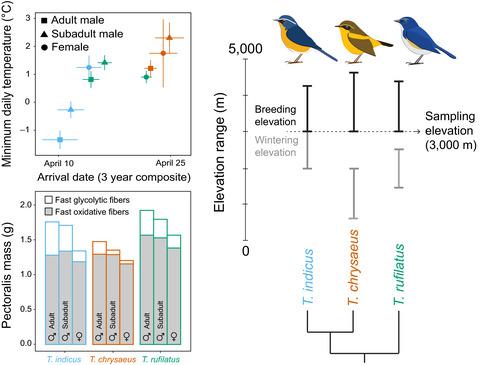当前位置:
X-MOL 学术
›
J. Anim. Ecol.
›
论文详情
Our official English website, www.x-mol.net, welcomes your feedback! (Note: you will need to create a separate account there.)
Life history predicts flight muscle phenotype and function in birds
Journal of Animal Ecology ( IF 4.8 ) Pub Date : 2020-03-26 , DOI: 10.1111/1365-2656.13190 Shane G DuBay 1, 2 , Yongjie Wu 3 , Graham R Scott 4 , Yanhua Qu 5 , Qiao Liu 6 , Joel H Smith 7 , Chao Xin 8 , Andrew Hart Reeve 9 , Chen Juncheng 3 , Dylan Meyer 7 , Jing Wang 5, 10 , Jacob Johnson 7 , Zachary A Cheviron 11 , Fumin Lei 5, 10 , John Bates 2
Journal of Animal Ecology ( IF 4.8 ) Pub Date : 2020-03-26 , DOI: 10.1111/1365-2656.13190 Shane G DuBay 1, 2 , Yongjie Wu 3 , Graham R Scott 4 , Yanhua Qu 5 , Qiao Liu 6 , Joel H Smith 7 , Chao Xin 8 , Andrew Hart Reeve 9 , Chen Juncheng 3 , Dylan Meyer 7 , Jing Wang 5, 10 , Jacob Johnson 7 , Zachary A Cheviron 11 , Fumin Lei 5, 10 , John Bates 2
Affiliation

|
1. Functional traits are the essential phenotypes that underlie an organism's life history and ecology. Although biologists have long recognized that intraspecific variation is consequential to an animals' ecology, studies of functional variation are often restricted to species-level comparisons, ignoring critical variation within species. In birds, interspecific comparisons have been foundational in connecting flight muscle phenotypes to species-level ecology, but intraspecific variation has remained largely unexplored. 2. We asked how age- and sex-dependent demands on flight muscle function are reconciled in birds. The flight muscle is an essential multifunctional organ, mediating a large range of functions associated with powered flight and thermoregulation. These functions must be balanced over an individual's lifetime. 3. We leveraged within- and between-species comparisons in a clade of small passerines (Tarsiger bush-robins) from the eastern edge of the Qinghai-Tibet Plateau. We integrated measurements of flight muscle physiology, morphology, behavior, phenology, and environmental data, analyzing trait data within a context of three widespread, adaptive life-history strategies - sexual dichromatism, age and sex-structured migration, and delayed plumage maturation. This approach provides a framework of the selective forces that shape functional variation within and between species. 4. We found more variation in flight muscle traits within species than has been previously described between species of birds under 20 g. This variation was associated with the discovery of mixed muscle fiber types (i.e. both fast glycolytic and fast oxidative fibers), which differ markedly in their physiological and functional attributes. This result is surprising given that the flight muscles of small birds are generally thought to contain only fast oxidative fibers, suggesting a novel ecological context for glycolytic muscle fibers in small birds. Within each species, flight muscle phenotypes varied by age and sex, reflecting the functional demands at different life-history stages and the pressures that individuals face as a result of their multi-class identity (i.e. species, age, and sex). 5. Our findings reveal new links between avian physiology, ecology, behavior, and life history, while demonstrating the importance of demographic-dependent selection in shaping functional phenotypic variation.
中文翻译:

生活史预测鸟类的飞行肌肉表型和功能
1. 功能性状是构成生物体生活史和生态基础的基本表型。尽管生物学家早就认识到种内变异是动物生态学的必然结果,但功能变异的研究通常仅限于物种水平的比较,而忽略了物种内的关键变异。在鸟类中,种间比较是将飞行肌肉表型与物种级生态联系起来的基础,但种内变异在很大程度上仍未得到探索。2. 我们询问了鸟类对飞行肌肉功能的年龄和性别依赖性需求是如何协调的。飞行肌是必不可少的多功能器官,调节与动力飞行和体温调节相关的多种功能。这些功能必须在个人的一生中保持平衡。3. 我们利用来自青藏高原东部边缘的小型雀类(Tarsiger 丛林知更鸟)进化枝的种内和种间比较。我们整合了飞行肌肉生理学、形态学、行为学、物候学和环境数据的测量,在三种广泛的适应性生活史策略的背景下分析性状数据——性二色性、年龄和性别结构迁移以及延迟的羽毛成熟。这种方法提供了一个选择力的框架,这些选择力塑造了物种内部和物种之间的功能变化。4. 我们发现物种内飞行肌肉性状的变异比之前在 20 克以下的鸟类物种之间所描述的要多。这种变化与混合肌纤维类型(即快速糖酵解和快速氧化纤维)的发现有关,它们的生理和功能特性明显不同。鉴于通常认为小型鸟类的飞行肌肉仅包含快速氧化纤维,这一结果令人惊讶,这表明小型鸟类糖酵解肌纤维的新生态环境。在每个物种中,飞行肌肉表型因年龄和性别而异,反映了不同生活史阶段的功能需求以及个体因其多类身份(即物种、年龄和性别)而面临的压力。5. 我们的研究结果揭示了鸟类生理学、生态学、行为和生活史之间的新联系,同时证明了人口依赖选择在塑造功能表型变异方面的重要性。鉴于通常认为小型鸟类的飞行肌肉仅包含快速氧化纤维,这一结果令人惊讶,这表明小型鸟类糖酵解肌纤维的新生态环境。在每个物种中,飞行肌肉表型因年龄和性别而异,反映了不同生活史阶段的功能需求以及个体由于其多类身份(即物种、年龄和性别)而面临的压力。5. 我们的发现揭示了鸟类生理学、生态学、行为和生活史之间的新联系,同时证明了人口依赖选择在塑造功能表型变异方面的重要性。鉴于通常认为小型鸟类的飞行肌肉仅包含快速氧化纤维,这一结果令人惊讶,这表明小型鸟类糖酵解肌纤维的新生态环境。在每个物种中,飞行肌肉表型因年龄和性别而异,反映了不同生活史阶段的功能需求以及个体由于其多类身份(即物种、年龄和性别)而面临的压力。5. 我们的研究结果揭示了鸟类生理学、生态学、行为和生活史之间的新联系,同时证明了人口依赖选择在塑造功能表型变异方面的重要性。飞行肌肉表型因年龄和性别而异,反映了不同生活史阶段的功能需求以及个体由于其多类身份(即物种、年龄和性别)而面临的压力。5. 我们的研究结果揭示了鸟类生理学、生态学、行为和生活史之间的新联系,同时证明了人口依赖选择在塑造功能表型变异方面的重要性。飞行肌肉表型因年龄和性别而异,反映了不同生活史阶段的功能需求以及个体由于其多类身份(即物种、年龄和性别)而面临的压力。5. 我们的研究结果揭示了鸟类生理学、生态学、行为和生活史之间的新联系,同时证明了人口依赖选择在塑造功能表型变异方面的重要性。
更新日期:2020-03-26
中文翻译:

生活史预测鸟类的飞行肌肉表型和功能
1. 功能性状是构成生物体生活史和生态基础的基本表型。尽管生物学家早就认识到种内变异是动物生态学的必然结果,但功能变异的研究通常仅限于物种水平的比较,而忽略了物种内的关键变异。在鸟类中,种间比较是将飞行肌肉表型与物种级生态联系起来的基础,但种内变异在很大程度上仍未得到探索。2. 我们询问了鸟类对飞行肌肉功能的年龄和性别依赖性需求是如何协调的。飞行肌是必不可少的多功能器官,调节与动力飞行和体温调节相关的多种功能。这些功能必须在个人的一生中保持平衡。3. 我们利用来自青藏高原东部边缘的小型雀类(Tarsiger 丛林知更鸟)进化枝的种内和种间比较。我们整合了飞行肌肉生理学、形态学、行为学、物候学和环境数据的测量,在三种广泛的适应性生活史策略的背景下分析性状数据——性二色性、年龄和性别结构迁移以及延迟的羽毛成熟。这种方法提供了一个选择力的框架,这些选择力塑造了物种内部和物种之间的功能变化。4. 我们发现物种内飞行肌肉性状的变异比之前在 20 克以下的鸟类物种之间所描述的要多。这种变化与混合肌纤维类型(即快速糖酵解和快速氧化纤维)的发现有关,它们的生理和功能特性明显不同。鉴于通常认为小型鸟类的飞行肌肉仅包含快速氧化纤维,这一结果令人惊讶,这表明小型鸟类糖酵解肌纤维的新生态环境。在每个物种中,飞行肌肉表型因年龄和性别而异,反映了不同生活史阶段的功能需求以及个体因其多类身份(即物种、年龄和性别)而面临的压力。5. 我们的研究结果揭示了鸟类生理学、生态学、行为和生活史之间的新联系,同时证明了人口依赖选择在塑造功能表型变异方面的重要性。鉴于通常认为小型鸟类的飞行肌肉仅包含快速氧化纤维,这一结果令人惊讶,这表明小型鸟类糖酵解肌纤维的新生态环境。在每个物种中,飞行肌肉表型因年龄和性别而异,反映了不同生活史阶段的功能需求以及个体由于其多类身份(即物种、年龄和性别)而面临的压力。5. 我们的发现揭示了鸟类生理学、生态学、行为和生活史之间的新联系,同时证明了人口依赖选择在塑造功能表型变异方面的重要性。鉴于通常认为小型鸟类的飞行肌肉仅包含快速氧化纤维,这一结果令人惊讶,这表明小型鸟类糖酵解肌纤维的新生态环境。在每个物种中,飞行肌肉表型因年龄和性别而异,反映了不同生活史阶段的功能需求以及个体由于其多类身份(即物种、年龄和性别)而面临的压力。5. 我们的研究结果揭示了鸟类生理学、生态学、行为和生活史之间的新联系,同时证明了人口依赖选择在塑造功能表型变异方面的重要性。飞行肌肉表型因年龄和性别而异,反映了不同生活史阶段的功能需求以及个体由于其多类身份(即物种、年龄和性别)而面临的压力。5. 我们的研究结果揭示了鸟类生理学、生态学、行为和生活史之间的新联系,同时证明了人口依赖选择在塑造功能表型变异方面的重要性。飞行肌肉表型因年龄和性别而异,反映了不同生活史阶段的功能需求以及个体由于其多类身份(即物种、年龄和性别)而面临的压力。5. 我们的研究结果揭示了鸟类生理学、生态学、行为和生活史之间的新联系,同时证明了人口依赖选择在塑造功能表型变异方面的重要性。



























 京公网安备 11010802027423号
京公网安备 11010802027423号